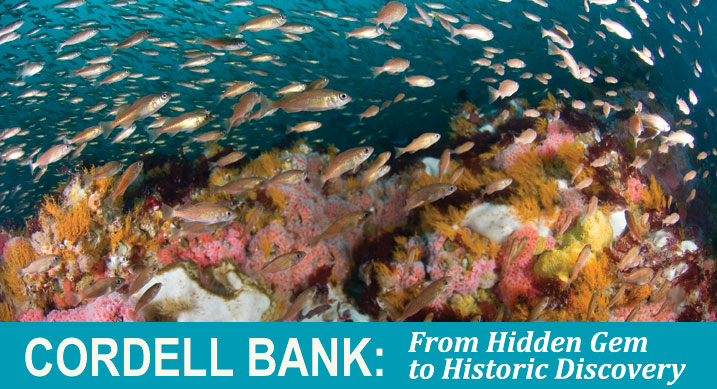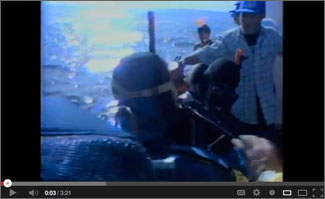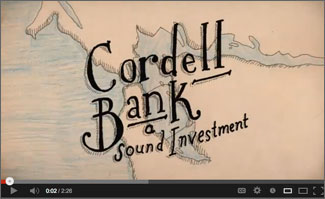


Sanctuary Shorts - Episode 1
"The Return to Cordell Bank" (6:15)
By Matt Dozier


In the early 1980s, a news crew traveled with Robert Schmieder to the site that he would later work to designate as Cordell Bank National Marine Sanctuary. Watch the original newscast that interviews Schmieder about being one of the first humans ever to see this amazing place.

Meet the tiny creature that plays a huge role in the complex web of ocean life at Cordell Bank National Marine Sanctuary. This hand-drawn short film was created by Drew Christie.

Sanctuary Radio Program: Ocean Currents on Community Radio for West Marin KWMR
Tune into Ocean Currents the first Monday of every month at 1:00 PM (Pacific Time).
The ocean covers 75% of our planet, we truly live on planet ocean! Discover the depths and far reaches of this watery realm by tuning in. We'll talk with experts in the field about current research, management issues, natural history, and stewardship associated with the marine environment, especially in our National Marine Sanctuaries.
Click here for more information.
By Matt Dozier
Robert Schmieder kept a firm grip on the line as he descended headfirst into the watery void, the noise of his scuba regulator bubbling rhythmically in his ears. Above him, the silhouette of the boat swayed placidly on the ocean’s surface.
Around 60 feet down, a greenish-gray blanket materialized out of the darkness below. His heart sank. Had they come all this way to find — what, exactly? A barren expanse of mud? As the hazy seafloor gradually came into focus, Schmieder realized that what he was looking at was not mud; it wasn’t the seafloor, at all. It was fish. Thousands of rockfish, floating almost motionless in the water column, formed a shimmering curtain that completely obscured his view of the bottom.
 At that moment, what went through my head was, ‘Holy smokes, I’m here.
I’ve seen it. No matter what else I do in my life, I have seen Cordell Bank.' At that moment, what went through my head was, ‘Holy smokes, I’m here.
I’ve seen it. No matter what else I do in my life, I have seen Cordell Bank.' |
A hole opened in the curtain of fish as Schmieder drew nearer, widening “like an iris” to reveal a sight he will never forget. “I saw below me this extraordinarily colorful, exquisitely beautiful, astonishingly bright landscape,” he recalls. “It was an overwhelming visual experience.” There, some 100 feet below the waves, lay the object of Schmieder’s obsession, the focus of months of arduous planning and preparation.
“At that moment, what went through my head was, ‘Holy smokes, I’m here. I’ve seen it. No matter what else I do in my life, I have seen Cordell Bank.’”
An Obsession Begins
Schmieder's quest begain in the late 1970s while he was working at
Sandia National Laboratories in
the San Francisco Bay Area. A career
physicist, he yearned to escape
the lab and pursue new projects
out in the field. He took up scuba
diving, but quickly grew bored of
underwater “sightseeing.” “I wanted
to do something that required
more than just the normal level of
effort,” he says.
When news reports in 1977 revealed that the U.S. government had stored radioactive waste in the ocean just off San Francisco, Schmieder was keen to investigate. He studied charts of the waters around the Farallon Islands, where hundreds of barrels of spent nuclear material lay at the bottom of the Pacific.
But something else caught his eye, something that made him forget about the barrels. There on the chart, not far from the islands, was an underwater mountain spanning some 26 square miles at the edge of the continental shelf. The name on the chart read “Cordell Bank.”
Schmieder had never heard of Cordell Bank. As it turned out, neither had pretty much anyone else. Those who knew about it dismissed it as a geological oddity, too deep to support plentiful life. He spoke to marine scientists at the California Academy of Sciences, who told him that exploring the bank would be a waste of time.
“That’s when I knew there was no competition for going out there,” Schmieder says. He was convinced that there was more to Cordell Bank than anyone realized, and decided that he would be the one to prove it.
The Right Stuff
Diving on the submerged mountain, 115 feet below the surface at its
highest point, in the unpredictable ocean conditions 22 miles off Point
Reyes would be difficult and dangerous work. For the expedition to succeed,
Schmieder needed people who could handle the demands of such a
strenuous environment.
Finding interested divers wasn’t a problem (“They found me,” he says), but not everyone was suited for the work. Schmieder required all wouldbe expedition members to do a rehearsal dive with him down to 150 feet — a daunting challenge, even by modern scuba standards.
“I told them, ‘You have to be obsessed by it. It’s going to require a lot of time, preparation and commitment in order to live through this,’” he says. “I found that about two-thirds of the people who said they wanted to go to Cordell Bank didn’t, after that.”
Despite the high dropout rate, Schmieder assembled a team and founded the nonprofit research group Cordell Expeditions in 1977. Working over long weekends and using their own money, these passionate men and women spent the next year drawing up meticulous plans and assembling gear for the massive undertaking.
Cordell Bank Goes Missing
On Oct. 22, 1978, the Cordell Expeditions vessel left the harbor and set a course for the nondescript blob on the chart labeled Cordell Bank.
First discovered by George Davidson of the U.S. Coast Survey in 1853,
Cordell Bank got its name from another surveyor, Edward Cordell, who
mapped the bank in detail in 1869.
Schmieder and his crew neared what should have been the shallowest part of the bank, but something was amiss. Every depth measurement registered hundreds of feet, far deeper than expected. “We spent hours that day surveying,” he says. “I say surveying — we were wandering, hoping to find Cordell Bank!”
As the team began to contemplate heading home, Schmieder thought back to the account of Edward Cordell’s expedition more than a century prior, in which the surveyor described an abundance of seabirds filling the skies over the bank. With nothing to lose, Schmieder steered the boat toward a nearby gathering of gulls, terns and shearwaters. “Sure enough, bingo, we hit 20 fathoms!” he says. The mission was back on.
The descent line was lowered as Schmieder and fellow diver Larry Pfoutz prepared to get in the water, donning thick wetsuits and dual scuba tanks. Moments later, the two men took a long stride off the stern of the boat and plunged into the unknown.
From Curiosity to Concern
On that first dive, Schmieder was awed by the kaleidoscope of life atop
the bank, with its hues of pink and purple and orange and white. Here,
just 50 miles northwest of the heart of San Francisco, was a thriving marine
ecosystem unlike anything he’d ever seen. He realized immediately
that it was a special place — but also a fragile one.
The team worked to document every aspect of Cordell Bank and its marine life over the next several years, returning to the site as often as time and funds would permit. “We were pretty much getting an idea of what the place was like,” Schmieder says. Every trip yielded new charts, photographs and scores of creatures like sponges, sea stars and hydrocorals for their records, including several undescribed species. Still, amid the excitement of exploration and discovery, doubts about the future of Cordell Bank lingered. Around 1980, Schmieder learned about the National Marine Sanctuary System and its ongoing efforts to protect some of California’s most iconic ocean places. He wasted no time in contacting Dr. Nancy Foster, then director of the sanctuaries, to ask if NOAA would be interested in making Cordell Bank a sanctuary.
Her response was an emphatic “yes.” All she needed was for Schmieder to submit a formal letter nominating the sanctuary for designation. Much to her surprise, he refused.
Getting the Whole Story
“I felt that I had an incomplete story,” Schmieder recalls. “I was worried
that if I went forward with the nomination, someone would say, ‘This
doesn’t look like much!” He argued that more research remained to be
done before they could claim to have a full description of Cordell Bank.
The sanctuary program agreed to give Cordell Expeditions more time — and additional funding — to complete its surveys of the bank. From that point on, the expedition took on a new meaning for Schmieder and his band of amateur marine scientists. “We were no longer explorers in our own little world,” he says. “We were a part of history. And we took that very seriously.”
By 1983, Schmieder decided that they had gathered sufficient information to make the case for sanctuary protection of Cordell Bank. He wrote a letter officially nominating the sanctuary, setting the wheels of bureaucracy in motion.
Looking to the Future
In the years following, Schmieder’s connection to Cordell Bank gradually
waned. His team concluded their research in 1985, and others took
up the mantle of sanctuary designation. He says he watched the process
with a mixture of great pride that Cordell Bank would be protected and
disappointment that it was no longer “his” secret place.
The sanctuary process languished until 1989, when Representative Doug Bosco introduced a bill co-sponsored by then-representatives Barbara Boxer and Nancy Pelosi to push the designation through. Just like that, on May 24, the sanctuary was signed into law by President George H. W. Bush. Schmieder’s role in the sanctuary’s creation was largely overshadowed by the fanfare of the congressional designation, but he knew that he had been part of something momentous. And indeed, without his leadership and tremendous personal investment in the future of Cordell Bank, it might never have happened.
“There’s no way I can adequately say how gratifying it is to see that what we did lives on.”